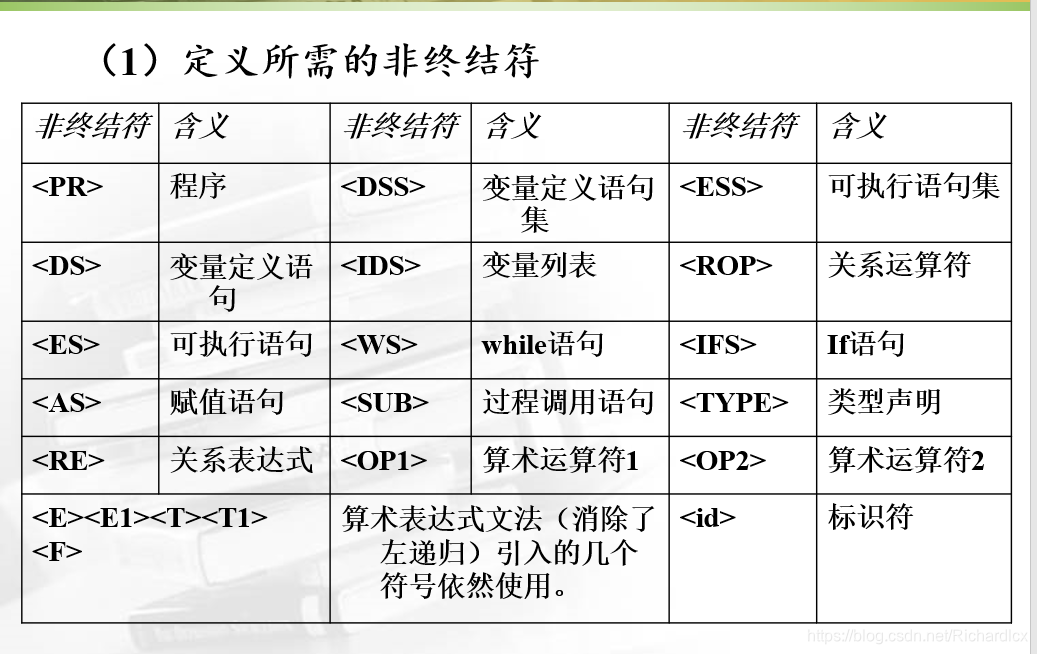文章目录
一、实验目的
理解自顶向下语法分析的基本模式,熟悉递归下降分析程序的构造。
二、实验原理与要求
1、原理
每个非终结符抽象为一个函数,语法树的上下级关系对应于函数的递归调用。
2、要求
(1)针对一个具体语言子集,设计出相应的文法。
(2)递归过程按规定的模式。
(3)测试用例覆盖每个产生式候选。
三、实验设备
配置有C/C++开发环境的计算机设备。
四、实验内容
采用递归下降分析法对变量定义语句、赋值语句、while语句、if语句进行语法分析。对每个非终结符设计递归子函数。
五、实验步骤
1. 单词内码表
在实验一 词法分析程序的设计的基础上,要求考虑while语句、if语句。以下为一参考实现:

2. 定义语言文法
选取高级语言的部分语句,先定义其中所涉及的非终结符:



说明:
(1)把识别出来的单词均作为终结符对待。
(2)在本实验中用单词种类编号表示单词,所以和当前输入符号比较的时候比较的是单词种类编号。例如:
if(str[ip]==’(‘) 改成 if(str[ip]==19)
else if(str[ip]==’a’) 改成 else if(str[ip]==100)
3. 语法分析器的实现(编码)
// -*- coding: utf-8 -*-
// @ Date : 2020/5/20 13:14
// @ Author : RichardLau_Cx
// @ file : Richard.cpp
// @ IDE : Dex-C++
// @ Source : 编译原理实验
#include <iostream>
#include "实验一 词法分析程序.cpp" // 调用实验一的代码文件
using namespace std;
typedef int vtType; // 终结符类型,用实验一识别出的单词作为终结符,并且用单词的种类编号(int)表示单词
vtType lookAhead; // 用来存放当前读出的输入符号(即:存放从Result[]中,当前读出的单词)
char value[100]; // 读出当前单词的内码值
int ip=0; // ip指向从Result[]中,当前读出单词的下标
// lookAhead = Result[ip].typeNumber
void error2();
void match();
void PR();
void DSS();
void DS();
void TYPE();
void ES();
void ESS();
void IDS();
void WS();
void IFS();
void AS();
void RE();
void E();
void ROP();
void T();
void E1();
void OP1();
void OP2();
void F();
void T1();
void grammar();
void error2()
{
cout << endl << "语法发现错误!位置为:" << ip << endl;
exit(0);
}
void match()
{
// 当前输入符号和推导过程中,待匹配符号相等,则“匹配 ”,输入串指示器ip指向下一个输入符号
ip++;
lookAhead = Result[ip].typeNumber; // 读出下一个符号种别编码
// value = Result[ip].code; // 读出下一个符号内码值
}
void PR()
{
// <PR> -> <DSS><ESS>
DSS();
ESS();
}
void DSS()
{
// <DSS> -> <DS><DSS> | ε
if (lookAhead == 4 || lookAhead == 5 







 最低0.47元/天 解锁文章
最低0.47元/天 解锁文章















 2307
2307











 被折叠的 条评论
为什么被折叠?
被折叠的 条评论
为什么被折叠?








